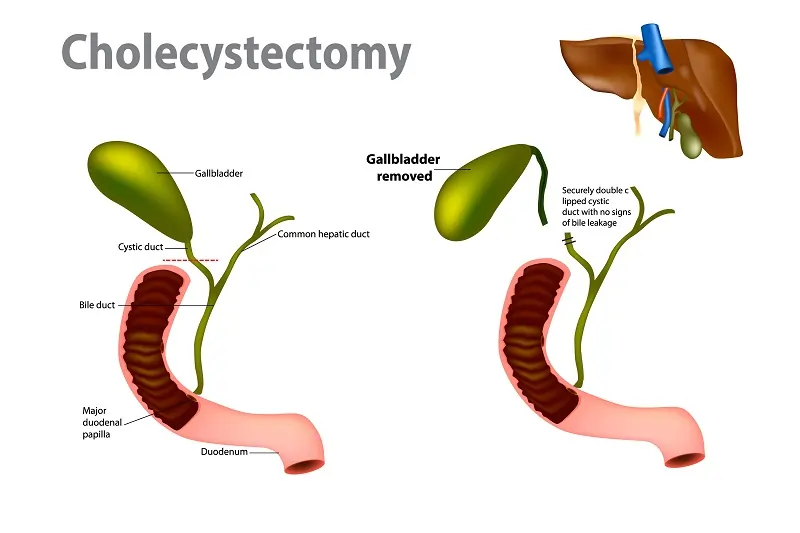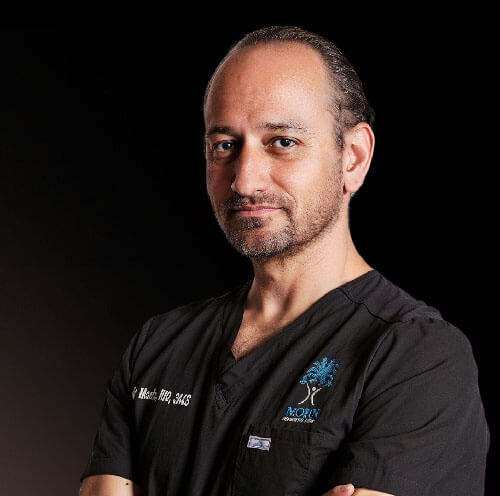
Gallbladder Surgery Los Angeles, CA
Are you one of the unfortunate individuals forced to endure gallstones? Gallstones don't go away on their own, unfortunately. Over time, they can cause pain and other symptoms.
At Healthy Life Bariatrics, Dr. Moeinolmolki can diagnose gallstones and gallstone-related problems. Gallbladder surgery is the recommended treatment for gallstones and gallstone pain. 80% of people who experience gallstones will eventually require surgical intervention.
In most cases, Dr. Moein will perform gallbladder surgery laparoscopically.
Evaluating Gallbladder Symptoms
Typical gallbladder-related signs and symptoms may include [3]:
- Severe sudden pain after eating fatty or greasy foods - Especially in the upper abdomen near the liver
- Nausea or vomiting
- Fever, chills, or jaundice with infection
- Biliary colic with intermittent intense gallbladder contraction pain
- Chronic diarrhea or light-colored stools from bile flow disruption
While “silent” stones cause no symptoms initially in 20% of people, eventual irritation and inflammatory changes usually provoke attacks [4]. If episodes increase in frequency or severity, prompt surgical consultation determines appropriate intervention timing.
Diagnosing Gallbladder Disease Gallbladder Surgery Los
Before performing surgery, doctors confirm gallbladder pathology through [5]:
- Physical Exam – Tenderness elicited with palpation of the upper right quadrant
- Blood Tests – Signs of infection, liver dysfunction, or common bile duct blockage
- Transabdominal Ultrasound – Best initial study showing gallstones, abnormal anatomy, masses, polyps, or thickened walls
- HIDA Cholescintigraphy – Checks gallbladder ejection fraction and bile transit throughout
- MRCP or ERCP – Further detail biliary tracts and rule out duct stones if indicated
Once characteristic presentations and imaging verification identify a clear culprit of gallbladder disease, surgical removal cures the underlying issue.
How Does Dr. Moein Perform Laparoscopic Cholecystectomy?
After making the incisions, Dr. Moein uses laparoscopic tools to gain a clear view of your gallbladder. The gallbladder is removed, and the surgical sites are closed. You will be provided with general anesthesia, which means you'll be asleep through the procedure. You won't feel any pain and will wake up following the surgery.
Several techniques exist for removing diseased gallbladders, with the least invasive laparoscopic cholecystectomy used most frequently and safely at over 90% of cases nationally.
Open Cholecystectomy involves a sizeable abdominal incision for direct gallbladder removal under visual guidance. Significant hospitalization and 4-6 week recovery were historically needed. Now, it is rarely utilized given the invasive impact, except emergently with complicating infection issues that preclude other options.
Laparoscopic Gallbladder Surgery utilizes a camera and instruments inserted through several small abdominal incisions, allowing magnified internal operating views guiding careful gallbladder dissection from liver attachments circumferentially before removal through a trocar. Now, the standard routine technique with 23-hour observation and 1-week recovery averages.
Single Incision Laparoscopic Surgery (SILS) uses one concealed belly button entry point for all the ports to further limit surgical trauma. Cosmetically appealing but technically challenging without outcome advantages versus standard multi-port laparoscopy.
Is Gallbladder Removal Surgery Always Necessary?
If you have gallbladder stones that don't cause pain, you may not require surgery. Surgical intervention is not always necessary when gallstones are present.
When gallstones cause you chronic pain or when one of your bile ducts becomes obstructed, surgery is recommended. We refer to gallstone blockages as gallbladder attacks. You'll know them by a sensation in your belly mimicking stabbing. The pain can last for hours, but surgery can help.
Gallbladder Removal Surgery for Special Cases
Dr. Moein may recommend surgical intervention involving gallbladder removal to guard against problems related to sickle cell or a blood disorder. This can be the case even if you do not currently experience symptoms.
Recovery Expectations After Gallbladder Surgery

Thanks to pioneering minimally invasive techniques, most patients now convalesce quickly after routine outpatient laparoscopic cholecystectomy. General recovery milestones include:
First Days Postoperative
- Overnight hospitalization for anesthesia recovery with pain control.
- Drain and bandage removal before discharge the following day typically.
- Resuming liquid diets immediately, then progressing food textures.
First Postoperative Week
- Using just ibuprofen or acetaminophen for residual abdominal soreness.
- Focusing on incision site care and light ambulation at home.
- Advancing nutrition and activity while avoiding lifting limits.
- Often back to office type deskwork after 7 days if comfortable.
Coming Weeks
- Having temporary swelling and drainage resolve.
- Slowly rebuilding stamina with light cardiovascular activity.
- Most restrictions are lifted after 2 weeks.
Months After Surgery
- Realizing substantial symptom relief and restoring bile digestion.
- Typically clearing patients for all normal activities without constraints.
- Assessing any lingering side effects requiring additional interventions.
Today, over 90% of laparoscopic gallbladder patients return home the same day of surgery and, observably, get back to normal life activities within 7-14 days [14]. Medical teams support optimal convalescence through coordinated post-hospitalization follow-ups.
Potential Operative Complications
All surgeries pose risks, but routine laparoscopic gallbladder surgery proves exceptionally safe, with mortality rates of less than 0.2% [15]. Nonetheless, possible complications include [16]:
- Infection – Uncommon; antibiotics usually treat effectively when identified timely.
- Bile Leak – Duct injury risks spilling bile internally, causing pain. Often self-limited.
- Bleeding – Vessels sealing off nearly always, rarely needing transfusions.
- Gallstones Escaping – Overlooked loose stones entering the bowels cause intestinal obstructions passing through occasionally requiring urgent surgery if obstructing.
- Injury to Nearby Organs – Surgeons take care of avoiding collateral damage given anatomical proximity considerations.
Despite risks inherent with any surgery, straightforward laparoscopic gallbladder removal poses very low individualized complication profiles for most patients without complex comorbid hepatobiliary diseases.

Costs of Gallbladder Surgery in Los Angeles
Unfortunately, healthcare expenses loom large for many patients in the United States. Costs vary between Los Angeles hospitals and surgical practices based on case complexity, insurance network status, length of stay required, and supply chains. However, general billing ranges average [17]:
- Surgeon professional fees – Around $2000-4000 – Billed separately from facilities.
- Anesthesia fees – Approximately $1000-2000 – Also billed independently.
- Laparoscopic hospital surgery charges – Ranging from ~$15,000 30,000 – Vary by admission durations needed for monitored recovery.
Many patients initially meet deductible plan cost-sharing obligations until policy coverage benefits activate for percentage responsibility reductions. Realizing healthcare marketplace dynamics rightfully fuels requisite cost-benefit determinations, pursuing surgery when affordable.
Gallbladder Surgery Outcomes in Los Angeles
Patients today see excellent outcomes with advanced training and technologies proliferating, enabling routine outpatient laparoscopic cholecystectomy. Reviewing quality metrics across major Los Angeles hospitals finds [18]:
- Mortality rates less than 0.25% typically
- Intraoperative complications around 3%
- Conversion open surgery rates approximately 5%
- Postoperative complications under 6%
- Reoperations are needed in only 2% of cases
- Re-admissions back to hospitals within 30 days after discharge remains below 2%
Once recovered fully after surgery, over 95% of patients gain substantive symptom relief and restored digestion with diseased gallbladders excised.
What if We Don't Treat Gallstones?
Gallstones can lead to serious problems if left to progress. Several issues can develop, including cholecystitis (inflamed gallbladder), pancreatitis (inflamed pancreas), and cholangitis (inflamed bile ducts).
Before Dr. Moeinolmolki can recommend surgery for gallbladder pain and other issues, several tests are necessary to determine the effects gallstones may be having on your health.
Tests for gallbladder issues include blood draws, ultrasound imaging, MRI HIDA (hepatobiliary iminodiacetic acid) scan, and endoscopic ultrasonography. These advanced imaging devices can also identify the location of your gallbladder issues and often the severity of the condition.
Can We Use Other Treatments Instead of Gallbladder Surgery?
Dietary changes can lead to diminished gallbladder symptoms. Cutting back on fatty foods can help, but not always. Your doctor may recommend medication to dissolve the gallstones, but they could always return.
Gallstone surgery is the only treatment that offers permanent results, which are overwhelmingly positive results.
What is Recovery Like Following Gallbladder Surgery in Los Angeles?
Laparoscopic gallbladder surgery offers less pain and faster healing than more open-type surgeries. Most patients return home from our Healthy Life Bariatrics surgical center on the same day.
In most cases, you can expect to return to your normal activities within two weeks.

Are There Risks to Gallbladder Surgery?
You can live just fine without a functioning gallbladder. Your liver makes bile well enough on its own. The bile created by your liver will eventually find its way to your small intestine for proper digestion, even if your gallbladder is removed.
While gallbladder surgery is common and safe, risks are present.
You may have problems with anesthesia, develop an infection, or experience bile leakage. Bleeding could result in blood clots or damage to your bowels.
All surgeries come with risks. That is why you must put significant effort into finding a reputable general surgeon. When you choose Healthy Life Bariatrics for your general surgical needs, you are in good hands with Dr. Babak Moeinolmolki.
Schedule a consultation with Dr. Moein by calling us throughout Los Angeles, Encino, or Glendale, California – (310)861-4093.

